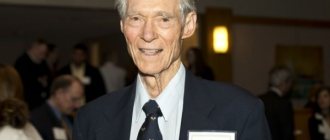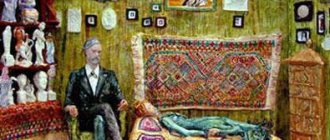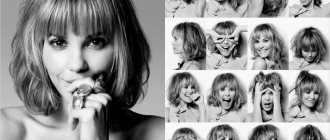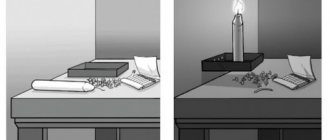Origin
William James is American. He studied philosophy and psychology.
Karl Lange is a Danish anatomist and physician. Two scientists, independently of each other, at the same time, came to the same conclusions in the field of human emotions.
As a result, James Lange's theory of emotions was formed, which won the minds of many followers. In 1884, Mind magazine published an article by James entitled “What is Emotion?”, where the author shows that when an emotion is cut off from its external manifestations, nothing remains of it. It is worth noting that this hypothesis was quite unexpected and paradoxical for this area of scientific knowledge. William James suggested that the signs that we observe and attribute to the consequences of an emotion are its cause.
Our body reacts to changes in the environment, its conditions and, as a result, reflex physiological reactions unconsciously arise in it.
These include increased secretion of glands, contraction of certain muscle groups and similar manifestations. A signal is sent to the body about all these changes. It is sent directly to the CNS (central nervous system). As a result, emotional experiences are born. This means, as James Lange’s theory of emotions tells us, a person does not cry out of sadness, but on the contrary, he becomes sad as soon as he cries or just frowns.
Theory[edit]
Emotions are often considered judgments about a situation that cause feelings and physiological changes. In 1884, psychologist and philosopher William James proposed that physiological changes actually precede emotions, which are equivalent to our subjective experience of physiological changes and are experienced as feelings. In his words, “our sense of the same changes that are taking place is
emotion". [4] James stated: [5]
If we imagine some strong emotion, and then try to abstract from our consciousness of its all the sensations inherent in its characteristic bodily symptoms, we find that we have nothing left behind, no "mental stuff" of which it can be composed. emotion, and that all that remains is a cold and neutral state of intellectual perception. ... What kind of emotion of fear would remain if there were no feelings of rapid heartbeat, shallow breathing, trembling lips, weakened limbs, goose bumps, or internal stirring - it is completely impossible to think. Is it possible to imagine a state of anger and imagine that it does not boil in the chest, does not flush redness to the face, does not dilate the nostrils, does not clench the teeth, does not have a desire for energetic actions, but instead - relaxed muscles, calm breathing. , and a serene face? On the one hand, the author of this article definitely cannot. The rage completely evaporated, as did the sensation of its so-called manifestations.
Physician Carl Lange independently developed similar ideas in 1885. [2] Both theorists defined emotion as the feeling of physiological changes caused by a stimulus, but the theorists focused on different aspects of emotion. [1] While James did talk about the physiology associated with emotion, he was more focused on conscious emotions and the conscious experience of emotions. For example, a crying person believes that he is sad. Lange reinterpreted James's theory by applying it. He made James's theory more tested and applicable to real-life examples. [6]However, both agreed that if physiological sensations could be eliminated, there would be no emotional experiences. In other words, physiological arousal causes emotions. [1]
According to James, when a person is aware of their body's physiological arousal and emotional behavior, their emotions manifest themselves. He did not believe that common sense reactions were real, but that each emotion produced a specific physiological response. For example, when someone hears glass breaking and thinks that someone is breaking, their heart starts pounding and they shake, James will argue that they are experiencing this physiological reaction because they feel fear or might become a burglar. Or, if a person heard glass breaking and thought it was their roommate being careless and clumsy, their heart would race and their blood pressure would rise due to the target's anger, according to James.
James states that the sequence of events when experiencing emotions is:
Emotional stimulus → Physiological response pattern → Affective experience.
The theory itself emphasizes that physiological arousal, excluding emotional behavior, is the determining factor of emotional feelings. He also emphasizes that each emotional feeling is associated with a unique pattern of physiological responses. It must meet two criteria which include (a) at least two emotions must be evoked and (b) the presence of any emotion must be verified through other measures such as facial expressions or verbal reports. An example would be conducting an experiment to measure happiness and anger. One study measures happiness but provides occasional rewards throughout the experiment, while another study measures anger by asking participants to solve very difficult crossword puzzles. Their physiological responses - blood pressure and electrodermal responses - will be measured. Verbal and facial expressions will also be studied to determine happiness or anger. According to James, the results will show that physiological patterns, blood pressure and electrodermal responses will show different patterns for different emotions.
Further researchers also discovered that there are several specific physiological differences between individual emotions. For example, studies have shown that heart rates are always higher in people experiencing anger and fear than in those experiencing happiness or even sadness. It also shows that blood pressure is also higher in those who experience anger than in those who experience fear, sadness and happiness. It also showed that electrodermal responses were greater in people experiencing fear than during sadness. But there were also cases where the physiological patterns did not differ, which implies that this theory is not 100% accurate and that there was not a unique pattern for each major and individual emotion. This led them to blame the autonomic nervous system, because the autonomic nervous system reacts globally rather than demonstrating these individual responses in an emotion-eliciting situation, and people also typically notice only changes in their autonomic nervous system rather than any specific physiological changes. Which ultimately comes to the conclusion that our own perception of our body's physiological responses does not provide sufficient evidence and evidence to determine the objective nature of an emotional experience.t provide enough evidence and evidence to determine the objective nature of an emotional experience.t provide enough evidence and evidence to determine the objective nature of the emotional experience.[7]
The specific pathway associated with the experience of emotions was also described by James. He stated that the object affects a sense organ, which transmits the information it receives to the cerebral cortex. The brain then sends this information to the muscles and viscera, which causes them to react. Finally, impulses from the muscles and internal organs are sent back to the cortex, transforming the object from “an object merely perceived” to “an object which is felt emotionally.” [1]
James explained that his theory was counterintuitive. For example, while most would think that the order of emotional experiences would be that a person sees a bear, gets scared and runs away, James thought that a person first has a physiological reaction to the bear, such as trembling, and then becomes afraid. and runs. According to James, the physiological reaction comes first, which is perceived as an emotion, and then the reaction follows. [8]
Application of knowledge
If a person wants to have pleasant experiences, he needs to behave as if this has already happened. If you are in a bad mood, then you need to start smiling! You need to train yourself to smile. Only in this way will a person begin to feel like a cheerful person.
The meaning that James Lange's theory of emotions puts into such actions is that a person shapes his environment with his external expressions (smile, frown). Only after this does the environment itself have a certain influence on the person.
It is not difficult to notice that people unconsciously avoid frowning faces. And this is understandable. Each person has enough of his own problems. He doesn't really want to run into strangers. If we see a smile on someone’s face that expresses optimism, then he wins us over and evokes a response in our soul.
Emotions
In sociology, emotions are most often conceptualized in terms of multidimensional characteristics, including cultural or emotional patterns (e.g., anger, pride, fear, happiness), physiological changes (e.g., increased sweating, changes in heart rate), and expressive facial and body movements (e.g. , smiling, frowning, showing teeth), as well as assessments of situational stimuli. A comprehensive theory of human emotional arousal was developed by Jonathan Turner. 30) Two key factors for arousing emotions in this theory are expectation and measures of responsibility. People who have certain expectations about how a particular encounter should unfold will experience different emotions, depending on how realistic the expectations are about themselves, the other person, and the situation itself. People may also engage in positive or negative behaviors directed at themselves or others, which also cause different emotional experiences in individuals. Turner has analyzed a wide range of theories of emotion in various fields of study, including sociology, psychology, evolutionary science, and neuroscience. Based on this analysis, he identified four emotions that all researchers found to be based on human neuroscience, including self-confidence-anger, disgust-fear, satisfaction-happiness, and frustration-sadness. These four categories are called primary emotions, and there is some agreement among researchers that these primary emotions combine to produce more complex emotional experiences. These more complex emotions are called first-order elaborations in Turner's theory, and include feelings such as pride, triumph, and awe. Emotions can also be experienced at different levels of intensity, so that feelings of anxiety are low-intensity variations of the primary emotions of disgust-fear, while depression is a higher-intensity variant. Attempts are often made to regulate emotions according to society's rules and situations based on many (sometimes conflicting) demands and expectations. Feelings of anger in many cultures are discouraged in girls and women, while fear is discouraged in boys and men. Expectations attached to social roles, such as “act like a man” rather than a woman, and the accompanying “rules of feeling” contribute to differences in the expression of certain emotions. Some cultures reward or discourage happiness, sadness, or jealousy, and freely expressing the emotion of disgust is considered socially unacceptable in most cultures. Some social institutions are believed to be based on a certain emotion, such as love in the case of the modern institution of marriage. Emotional appeals are often found in advertising, such as health campaigns and political appeals. Recent examples include anti-smoking campaigns and political campaigns emphasizing fears of terrorism. Social scientists' attention to emotions has varied over time. Emile Durkheim (1915/1965) wrote about the “collective effervescence” or emotional energy experienced by participants in totemic rituals in Australian Aboriginal society. He explained how during totem rituals a state of heightened emotional energy is achieved that elevates a person and makes him feel as if he is in the presence of a higher power, a power that resides in the sacred objects that were worshiped by members of the community. He argued that this feeling of exaltation ultimately leads a person to believe in the existence of powers that are hidden in sacred objects. In the 1990s, sociologists focused on various aspects of specific emotions and their social significance. For Cooley (1992), pride and shame were the most important emotions that lead people to take various social actions. He suggested that during each meeting, we monitor ourselves as if through a “mirror”, which represents the gestures and reactions of other people. Depending on these reactions, we experience either pride or shame, which leads to specific actions. Retzinger (1991) 31 conducted a study of married couples who experienced cycles of anger and shame. Drawing primarily on the work of Goffman and Cooley, Sheff (1990) developed a micro-sociological theory of social bonding. The formation or destruction of social bonds depends on the emotions that people experience during interaction. Building on these findings, Randall Collins (2004) formulated his theory of ritual interaction, drawing on Durkheim's work on totemic rituals, which was expanded by Goffman's (1964/2013, 1967) 32 description of daily meeting rituals. Based on ritual interaction theory, we experience different levels, or intensities, of emotional energy during face-to-face interactions. Emotional energy is considered to be the feeling of confidence to take action and the courage that an individual experiences, “charged” by the “collective effervescence” during group meetings that reaches high levels of intensity. An increasing number of studies are using the sociology of emotions to understand students' learning experiences during classroom interactions with instructors and other students (e.g. Milne and Otieno 2007; Olitski 2007; Tobin et al 2013; Zembylas 2002 33)). These studies suggest that academic subjects can be understood in terms of rituals of classroom interaction that create emotional energy and collective states of emotional arousal, the emotional climate. In addition to the ritual interaction traditions in the sociology of emotions, other approaches have been classified into 6 other categories (Turner, 2009), including: evolutionary/biological theories, symbolic interactionist theories, dramaturgical theories, ritual theories, power and status theories, stratification theories, and exchange. This list provides a general overview of the different traditions in the sociology of emotions, which sometimes conceptualize emotions differently and sometimes complement each other. Many of these different approaches were synthesized by Turner (2007) in his sociological theory of human emotion in an attempt to create one comprehensive sociological theory drawing on developments from many of the above-mentioned traditions. 34)
What strengths did James Lange's theory of emotions show from experiments?
People who participated in the testing process had to evaluate the proposed cartoons and jokes. They held a pencil in their mouth. The point was that some held it with their teeth, and others with their lips. Those who had a pencil in their teeth involuntarily feigned a smile, while others, on the contrary, showed a frown and tension. So, those who had a smile found the proposed cartoons and jokes funnier than the second group.
It turns out that James Lange's peripheral theory of emotions has some basis. It tells us that emotional states are a secondary phenomenon. It manifests itself as awareness of signals coming to the brain that produce changes in internal organs, muscles and blood vessels. In turn, these changes occur at the moment of implementation of a behavioral act, as a consequence of an emotiogenic stimulus.
Cannon-Bard theory of emotions
In the 1930s, Walter Cannon and Philip Bard developed their theory as an argument against the James-Lange theory described above. According to psychologists, physiological reactions and emotions occur simultaneously. An emotion occurs when the thalamus, an area of the brain that controls motor function, sleep-wake states, and sensory processing, reacts to a specific stimulus and sends a specific message to the brain, resulting in a physiological response.
The mechanism of emotion is shown in the figure below.
The sense organs are affected by a certain initial stimulus. Next, it is transmitted to the cerebral cortex, where an analysis occurs of how this reaction will be directed, which, in turn, activates the thalamus - that is, the stimulus is perceived and interpreted. After this, two reactions occur simultaneously: emotional and physiological. In other words, when you meet a lion, you will feel a strong heartbeat and trembling at the same time as strong fear.
Confirmation
Vera Birkenbiel, a German psychologist, suggested that people who took part in experiments, when upset or worried, should retire for a while and try to give a joyful expression to their faces. To do this, you could apply force and force the corners of your lips to rise, and then hold them in this position for 10 to 20 seconds. The psychologist claims that there has never been a case where this forced smile did not develop into a real one.
Thus, the practical application of James Lange's peripheral theory of emotion shows that the kinesthetic cues that trigger emotions are at work.
What are the weaknesses of the theory?
The range of human body reactions is more limited than the range of emotional experiences. One organic reaction can be combined with very different feelings. It is known that when the hormone adrenaline is released into the blood, a person becomes excited. However, this excitement can take on different emotional connotations. It depends on external circumstances.
But, according to James Lange's theory of emotions, this is not entirely correct when the emotional state depends on external circumstances. This means that the theory still has weaknesses.
Participants in one experiment, unbeknownst to them, had their blood adrenaline artificially increased. In this test, people were divided into two groups: the first was in a relaxed, fun environment, and the second was in an anxious and depressing atmosphere. As a result, their emotional state manifested itself in different ways: joy and anger, respectively.
It turns out that James Lange's theory of emotions, in short, shows that a person becomes afraid because he trembles. However, it is known that trembling in the body also occurs from anger, sexual arousal and some other factors. Or take, for example, tears - they are a symbol of sadness, anger, grief and, at the same time, joy.
James–Lange theory
Physical changes during emotions are so striking that their role in emotions has long been noticed. What significance do they have? Usually the following order is presented: external irritation causes a mental reaction, for example, fear, as a result of which a shudder “from fear” and heart palpitations appear.
Lange (1890), James (1892) put forward the theory that emotions are the perception of sensations caused by changes in the body due to external irritation. External irritation, which causes affect, causes reflex changes in the activity of the heart, breathing, blood circulation, and muscle tone. As a result, different sensations are experienced throughout the body during emotions, which make up the experience of emotions.
They usually say: we have lost a loved one, we are upset, we cry; we met a bear, we were scared, we were shaking; we are insulted, enraged, we strike. And according to the James-Lange theory, the order of events is formulated as follows: we are sad because we cry; we are afraid because we are trembling; enraged because the volume. If bodily manifestations did not immediately follow perception, then, in their opinion, there would be no emotion.
If we imagine some emotion and mentally subtract from it one by one all the bodily sensations associated with it, then in the end there will be nothing left of it. So, if from the emotion of fear you eliminate heartbeat, difficulty breathing, trembling in the arms and legs, weakness in the body, etc., then there will be no fear. Those. human emotion, devoid of any bodily lining, is nothing more than an empty sound.
Emotions can arise without any impact on the psyche, under the influence of purely chemical and medicinal influences. It is known that wine “makes a person’s heart happy”, with wine one can “fill out melancholy”, thanks to wine fear disappears - “a drunken sea is knee-deep”.
Fly agaric causes fits of rage and a tendency to violence. Fly agaric infusion
in the old days it was given to warriors to put them in a “bloodthirsty state.” Hashish can cause violent fits.
Emotions also arise under the influence of internal causes in pathological cases. With diseases of the heart and aorta, melancholy appears. In many diseases, fear or joy appear without direct objects of these emotions: the patient is afraid, without knowing what, or is happy for no reason. Emotions are expressed by facial expressions, tongue movements, exclamations and sounds.
DISGUST
The expression "disgust" in its first simplest sense refers to food and denotes something disgusting to the taste ("turning away" is a negative reaction to food).
With an average degree of disgust, the mouth opens, the corners of it are pulled down and a guttural sound is made or coughing, while simultaneously shuddering and pushing away from the unpleasant object. At weak degrees, disgust is expressed by pulling down the corners of the mouth, wrinkling the nose, and sometimes exhaling through the nose, as one does when there is an unpleasant odor, wanting to remove it. Not only the expression of disgust for food substances, but also the manifestation of any other disgust is based on this facial expression. Aversion to appearance, to conversation, to the moral qualities of a person, etc. has the same facial expressions of food disgust: the same movements of the mouth, tongue, flinching, pushing away gesture and guttural sounds.
Contempt, mockery, and disdain all over the globe are expressed by facial expressions and gestures representing the throwing away or removal of an unpleasant object.
EXPRESSION OF FUN AND JOY
A cheerful mood is expressed in laughter, aimless movements, general excitement (exclamations, clapping, etc.). Laughter in a person begins with inhalation, followed by short spasmodic contractions of the chest, abdominal barrier and abdominal muscles; when laughing, the whole body leans back and shakes, the mouth is wide open, the corners of the lips are pulled back and upward due to the action of the large zygomatic muscles, the upper lip rises, the face and the whole head fills with blood, the orbicularis muscles of the eyes contract convulsively.
A wrinkled nose appears shortened, the eyes sparkle, and tears appear with strong laughter.
The expression of a cheerful mood can arise as an unconditioned reflex - due to bodily and organic sensations. Children and young people often laugh without any reason, presumably due to the positive tone of organic sensations that speak of the prosperous state of the body. In young, healthy people, a pleasant smell often causes a slight smile. Not only external stimuli cause a reaction of fun and joy, but also corresponding ideas find their expression in the laughter reflex.
Of all the emotions, the mechanism of internal processes is currently most elucidated with fear and, partly, anger. In view of the genetic connection of fear and anger with pain and the similarity of the physiological phenomena observed in all these experiences, we will first consider the phenomena of pain.
PAIN
The effect of pain on the psyche is similar to the effect of drives. If a dominant arises that suppresses all other excitations, then the desire to get rid of pain becomes stronger than all drives. Pain, having acquired a dominant character, forcibly determines a person’s behavior.
There are no relatively expressive movements during pain, but those that exist vary depending on its strength. Children, for example, even with mild pain, emit strong, prolonged screams, close their eyes, open their mouths and breathe convulsively. In adults, the reaction occurs with more severe pain. In excruciating pain, people rush about in terrible convulsions, tightly squeeze their mouths, clench their teeth, utter piercing screams and moans, and grind their teeth. If the pain is excruciating and long-lasting, then pallor appears, trembles, and strength declines; Fainting and delirium are possible.
FEAR
One of the most characteristic symptoms of fear is trembling of all the muscles of the body, often manifesting itself first of all on the lips. When fear increases to an agony of terror, we get a new picture of emotional reactions. The heart beats completely randomly, stops, and fainting occurs; the face becomes deathly pale; breathing becomes difficult; the gaze is directed to the object of fear, etc. In this case, the pupils are excessively dilated. All muscles become stiff and begin to move convulsively.
In most cases, fear arises from life experience. A small child is not afraid of heights and, boldly leaning down, falls out of the window, if he has not experienced a fall, etc. before. Only after experiencing pain under different conditions does he begin to fear what might cause pain.
What is called the “sense of self-preservation” is only partly innate,
mainly it develops during life on the basis of the pain experienced.
The participation of adrenaline in fear reactions is obvious. It gives strength to motor reactions, and, one might think, is involved in the immobilization reflex (“imaginary death reflex”). It is possible that in one amount adrenaline is a source of strength, in another it contributes to muscle numbness.
Different gradations of fear in a person are expressed in different ways: horror, panic,
fear, anxiety, fearful expectation, intimidation, downtroddenness, feelings of submission and devotion associated with fear. In a person with severe fear or horror, the following are observed: numbness, a panicky desire to run away, diffuse disordered muscle excitation. The numbness that occurs during fright, as a rule, quickly passes and can be replaced by motor excitement. For example, a person driven by fear can make such a leap over an obstacle, lift such a weight, and suddenly become capable of such tension that is unthinkable in a normal state.
Fear, if it does not reach a force that inhibits the psyche, can completely put thinking at its service. The thought is chained to one goal: to find a way out of the frightening situation. And fear can be experienced to such a weak degree that a person performs his usual work, the usual course of associations takes place, and fear lurks somewhere in the background, at the margins of consciousness.
Fear is a passive defensive reaction. It indicates the danger of something from someone stronger, a danger that must be avoided, from which it must be eliminated. If the threat comes from a weaker person, this will cause an actively defensive reaction - anger. Everything depends on the balance of forces.
It is clear that weak people, who find it more difficult to overcome life’s difficulties, have more reasons to react with fear.
Both children and adults have a fear of the unknown, of the new. This fear makes one cautious and has a protective value. When the knowledge of the world was insignificant, and the area of the unknown was enormous, fear held man in its power and forced him to populate the world with terrible monsters and gods. In a state of fear and after experiencing it, a series of vegetative
reactions.
ANGER
Anger in a person is expressed in the fact that the face turns red or purple, the veins on the forehead and neck swell, and sometimes the face becomes pale or blue. The mouth is tightly clenched, the teeth are clenched and grinding, and sometimes the lips are drawn out. Hair stands on end. Some people frown, others open their eyes wide. The body is usually held straight, the muscles are tense, and the person is ready for immediate action. Increased muscle arousal easily turns into action.
If a person in anger or rage tells someone to get out, he usually makes gestures as if he is hitting or pushing out the person being driven out. Often gestures become completely aimless, movements are uncoordinated, trembling is observed, lips do not obey the will, the voice breaks off.
Anger and indignation differ from rage in that their manifestations are less intense. When angry, cardiac activity is slightly increased, a blush appears, the eyes begin to shine, breathing quickens, the wings of the nose rise, the mouth usually contracts, and the eyebrows frown.
Already in the first days of life, a child can have an attack of anger by restricting his movements. In humans, it is only in childhood that rage is more often evoked as a reflex of physical struggle. Adults very rarely get into fights; this contradicts both the views of society and legal norms. The participation of anger in the facial reaction is manifested by raising the upper lip and baring the teeth. Thus, with anger, we see reactions that are unconditioned facial reflexes of struggle and corresponding reflexes of the autonomic nervous system.
EMOTIONS GENERATED BY THE SOCIAL ENVIRONMENT
Public opinion evaluates a person’s personal qualities: smart, stupid, cunning, handsome, etc.; determines the attitude of society towards his personality: respected, not respected, pleasant, unpleasant, etc., gives an assessment of his financial situation.
Everyone participates in creating their own assessments. He himself wants to have a certain
assessment in public opinion. Every person is sensitive to one degree or another.
to a judgment about him and reacts to public opinion about himself, to his position
in the eyes of society, places himself higher in some respects and lower in others
those around you. Determining one's attitude in this sense towards others can be
intellectual in nature, but much more often arises as emotional
reactions associated with intellectual processes. This includes such
emotions like pride, vanity, self-esteem, resentment and
etc.
ABOUT PRIDE
Pride (arrogance) in the mouths of the Russian people was a negative quality and was completely condemned, which was also reflected in the religious view of this feeling.
Pride, arrogance, and swagger, according to the popular imagination, are characteristic of those who rule and
the rich, the oppressors, the rapists and the abusers.
Pride finds outward expression in facial expressions and posture. Darwin describes this expression as follows: “A proud man shows his sense of superiority over others by holding his head and body erect. He is arrogant and tries to appear as large as possible, so they say about him in a figurative sense that he is puffed up with pride... In addition, the muscle that everts the lower lip is called the muscle of pride.”
Under the influence of the conditions of existence in human society, two series of reactions developed. Some are associated with the consciousness of one’s superiority and with the desire to elevate oneself: pride, arrogance, conceit, conceit, boasting, self-esteem, self-esteem. Others were generated by the consciousness of powerlessness: downtroddenness, timidity, fearfulness, self-doubt, a sense of humility, self-abasement, servility, ingratiation. In different classes of society, in different historical periods of time, different reactions were evoked and cultivated.
The feeling of superiority is associated not only with power or wealth. A person can be proud of superiority over others in the most diverse areas of life, he can be proud of success in the field of art and science, in all kinds of creative work. People who have achieved outstanding success in the fields of literature, music, and science have reason to be proud. Successful people can become “arrogant.” But pride may not have the tone of rude “arrogance,” and external manifestations and the nature of internal experiences may change.
ABOUT VANITY
Romain Rolland has this phrase: “What matters to a vain person is not what he is, but
what he appears to be." He wants to stand higher in the opinion of others than he is worth. A person strives to appear to others in a favorable light, and avoids a position in which he could make a repulsive impression. This is how “two-facedness” is created to one degree or another: one face for outsiders, the other for insiders. The difference between these faces can reach such a degree that the true face manifested in home life is completely different from the “official” face, the face for others. With a deceitful, selfish concealment of one’s true properties, one gets what is called hypocrisy. Praise and blame are the most powerful tools of influence of the social environment on its members. “Even those who are no longer afraid of anything in the world are afraid of ridicule” (Gogol). Society, through its opinion, regulates the behavior of its members. They thus find themselves, depending on him, becoming to one degree or another “slaves of social
opinions." The thought “what will they say?” sometimes receives paradoxically greater strength. Pride and vanity go hand in hand. A proud person, as a rule, is at the same time extremely sensitive to the opinions of others. The increased development of vanity, like pride, in different classes and strata of society is in connection with the life situation in a given class at a certain moment.
To place himself higher in the eyes of others, a vain person “plays all his trump cards” and experiences joy when he is successful. He is proud of having reached a prominent place, regardless of the ways in which it was obtained, he boasts of climbing a high mountain, his acquaintance with people who stand high in the opinion of society, his voice, his mind, his wit, his knowledge. At the same time, the vain person not only experiences joy, accepting these facts as proof of his importance, but joy stems from a feeling of superiority over others and receives a corresponding external expression.
If a person cannot achieve superiority over others in something big and
serious, then they will find an excuse to be proud of something.
Vanity, the desire for superiority where there is no direct path for a given person, appears in a disguised or veiled form, and follows roundabout paths. In order to attract sympathy, vain people can be affectionate, kind, helpful, and thereby arouse the opinion that this person has a great social sense.
Vanity affects the choice of profession, setting life goals, etc. The enemy's failure can be perceived as personal success. A person is always ready to devalue other people's successes and achievements with biased criticism. Envy does not allow you to be objective.
The vain person not only criticizes certain specific individuals, but often is generally critical of people, the “crowd,” and judges them down. A vainglorious feeling of superiority over people finds a variety of manifestations and can be interspersed into experiences in the form of separate features.
Self-deception is one of the most common types of lies in life. This is a kind of defensive reaction that allows you to maintain peace of mind and a sense of self-confidence. The development of vanity, like pride, depends on the conditions of social existence, on the individual conditions of development of a given individual. Its external manifestation and features of subjective refraction may be related to the intellectual and moral development of a given individual. It is related to a number of factors and represents a reaction as historically variable as pride.
ABOUT FLATTERY
The inability of a proud person to critically evaluate his own personality ensures the success of flattery. “They flatter,” as N.G. puts it. Chernyshevsky - then to dominate under the guise of submission.”
Every person is to some extent proud, everyone is pleased with what speaks of his value, what elevates him in his own and others’ eyes. The one who meets this need becomes pleasant, like a person who brings joy, while the unpleasant “truth hurts the eyes.”
Flattery and intrigue have always been the strongest means in the struggle for the favor of crowned and other high-ranking persons. Flattery found fertile soil in self-delusion associated with great power.
The success of flattery grows on the soil of vanity, and it is clear that vain people succumb to it most easily.
RESULT
When self-esteem is hurt, when a person realizes that he is humiliated in his personal opinion or in the opinion of society, the emotion of resentment arises. Insults and insults cause acute affect, which often leads to retaliatory “insult by action” or to more serious consequences. One should not think that a person who remained silent and only after a certain period of time showed his impatience with shouting, frenzy, blows, could during this period observe and direct his attention to something. He doesn't see or hear anything. He is completely at the mercy of a whirlwind of internal questions: “How dare he?! What is this, can I really bear it?!”
Resentment may, of course, not cause such an acute reaction. It may remain hidden and gradually disappear or lead not to an outburst of anger, but to a series of deliberate, varied actions, including revenge. Both the child and the adult, the stupid and the smart, experience resentment. Cicero said: “Insult causes pain that the wisest and best people can hardly bear.”
A proud, vain, proud person and a person with a high sense of self-esteem are, of course, more touchy, they have a kind of hyperesthesia in this regard, they see and suspect offense where it was not intended to cause it.
Traditions of countries
Often emotional expressions are determined by cultural norms. If we take a country like Japan into consideration, we can see that the manifestation of pain and sadness in the presence of persons of a higher position is a manifestation of disrespect. In this regard, when a Japanese person is reprimanded by a superior, he should listen to him with a smile. In Slavic countries, such behavior of a subordinate is considered insolence.
In China, too, it is not customary to bother higher-ranking, honorable persons with your grief. It has long been customary there to inform a person older in age and position about your misfortune with a smile in order to downplay the significance of grief. But the people of the Andaman Islands, according to their traditions, cry after a long separation when the meeting takes place. They also react to reconciliation after quarrels.
Criticism
It turns out that James Lange's peripheral theory of emotions, in short, doesn't quite work. Although, of course, psychologists use it in their practice. The result is usually most often positive. However, they always have to take into account a person's origins, cultural heritage and habitat.
This theory shows the ability to control emotions and inner feelings. A person is really capable, given a certain mood, of performing actions characteristic of one or another inner feeling. In this way he evokes the feelings themselves.
This theory was criticized by physiologists: Sherrington C.S., Cannon W. and others. They were based on data obtained in experiments with animals, which indicated that the same peripheral changes occur under different emotions and conditions not related to emotions. Vygotsky L.S. also criticized this theory due to the contrast between elementary (lower) emotions and true human experiences (higher, aesthetic, intellectual, moral).
Lazarus' theory of emotions
The cognitive theory of emotion, developed in the 1990s by Richard Lazarus, states that any emotion or physiological
activation of the body is certainly preceded by thought. In other words, before you have any emotion, you must comprehend the situation in which you find yourself.
Let's return to the above example. When a woman hears footsteps behind her, she first thinks that something is threatening her - for example, that she is being pursued by a robber - and only after that does her heart begin to beat faster, her body tremble, and she experiences a negative emotion - fear.
Thus, according to Lazarus’s theory (as well as Cannon-Bard’s), emotion and physiological activation of the body take place simultaneously.











